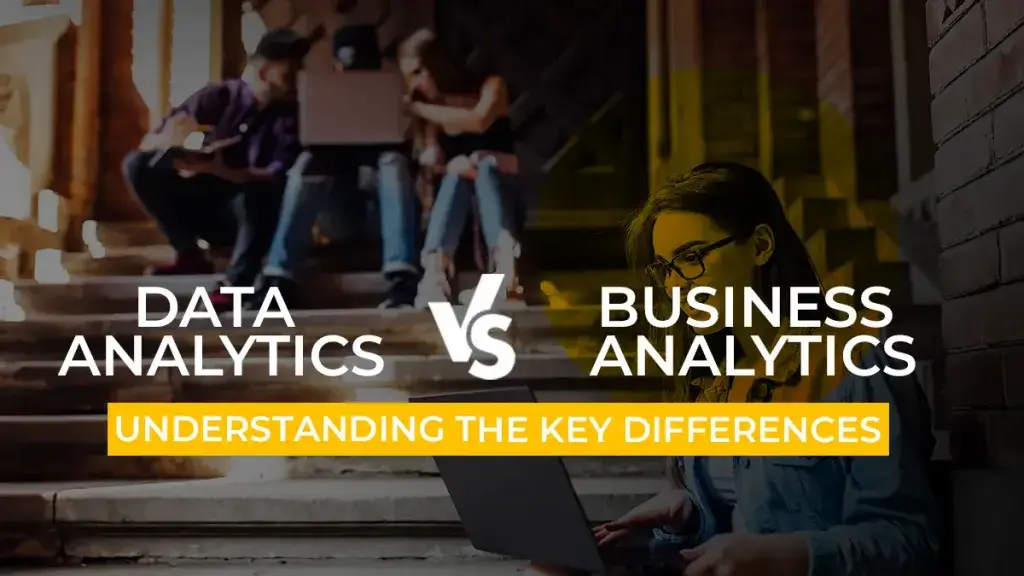Understanding the Key Differences Between Data Analytics and Business Analytics

Here's What We've Covered!
Have you ever wondered how big companies like Google and Reliance make important decisions for their businesses? Well, a major part of their decision-making is based on data-driven decision-making. This means that they use data and relevant information to make choices that can lead to better outcomes for the business and lead to its overall growth.
But wait, before we jump into how companies do so let’s first understand the differences between two important terms that come up when we discuss data-driven decision-making. These terms are Data Analytics and Business Analytics. You might have heard of these terms, but since they sound similar people often don’t understand what they truly mean. Well, don’t worry, we’ll clear up all your doubts about them in this blog.
So, be prepared because in this blog we will discuss the importance of data-driven decision-making, comprehend the distinctions between Data Analytics vs Business Analytics, and share some key points about data analytics vs business analytics along the way.
We just aim to help you understand and utilize the power of data in making smarter decisions for your business.
Defining Data Analytics
In simple terms, Data Analytics includes tools and technologies that help businesses to understand their data better.
Using Data Analytics is like cracking a puzzle by collecting lots of pieces of information and then putting them together to see the whole picture. Data analytics uses interesting tools like statistical analysis, which involves looking at numbers to find patterns, data mining to find important elements in a big pile of data, and then creating multicolor charts and graphs to make it easier to understand.
For example, in hospitals, Data Analytics can help to predict how patients are doing based on their reports and past medical records. In big retail stores, it can show what customers like to buy so that stocks can be arranged according to the demand. So, no matter what business you have using Data Analytics can help you make better choices for the business.
Also Read – Business analytics vs business intelligence – What’s The Difference
Understanding Business Analytics
Business Analytics is like having a superior tool to help businesses make smarter decisions.
Well, it’s all about using data to understand how a business is doing and how it can do better. For example, if you’re driving a car and using a GPS then it tells you where you are and helps you figure out the best route to reach your destination. Similarly, Business Analytics takes data from different parts of a business, like sales numbers or customer feedback, and uses it to figure out what’s working well for the business and what needs to be improved. Just like Data Analytics even this tool isn’t just for big companies but works for all kinds of businesses.
For example, in a restaurant, Business Analytics can help figure out which dishes are popular and when to offer discounts on them to attract more customers. So, whether you’re running a restaurant or any other business, Business Analytics can be like your compass to making better choices and reaching your goals.
Key Differences Between Data Analytics and Business Analytics:
From the above section now that you have understood what business analytics and data analytics are, let’s take a closer look at their differentiation factors. The following table will give you a detailed comparison of data analytics vs business analytics.
| Aspect | Data Analytics | Business Analytics |
| Primary Objective | Data Analysis:
|
Business Decision Enhancement:
|
| Applications Scope | Data Exploration:
|
Business Optimization:
|
| Focus | Statistical Analysis:
|
Business Strategy:
|
| Tools and Techniques |
|
|
| Skill Set | Technical Proficiency:
|
Business Acumen:
|
| Use Cases and Benefits | Customer Segmentation:
Churn Prediction:
Fraud Detection:
|
Market Forecasting:
Supply Chain Optimization:
Operational Efficiency:
profitability. |
Now that we’ve covered all aspects of data analytics vs business analytics most of your doubts should be cleared up and most of you must already be excited to explore this industry of data-driven decision-making. So in case you’re interested in studying business analytics and are looking for the right institution then your search stops here. Make sure to check out one of the top institutions called IMS Proschool for studying their business analytics course as it offers-
- At IMS Proschool, you can learn about really cool tools for analytics as they teach you how to use important tools like Excel, SQL, Tableau, Power BI, and Python.
- The professionals at IMS Proschool are super experienced in analytics as they’ve been working in the field for over 30 years! So you know you’re learning from the best.
- When you study at IMS Proschool, you get to do lots of fun activities in class because the professors and curriculum focus on making learning an exciting process by including real-world problems and an opportunity for students to work together with other students.
- In class, you also learn how to solve tricky problems so that you are prepared to face and figure out solutions to different problems that come up in business.
So no matter if you’re just starting your analytics journey or you already know a bit about these concepts, IMS Proschool has the best Business Analytics course for you.
Exploring Data Analyst vs. Business Analyst Roles and Salaries
When comparing the salaries of Data Analysts and Business Analysts, several factors come into the picture that influence compensation levels.
- Data Analysts focus on analyzing and interpreting data to support business decisions, whereas Business Analysts often have a broader role that includes understanding business objectives, processes, and strategies, and translating them into actionable insights and recommendations.
- As a result of these differences in responsibilities, the salaries for Data Analysts and Business Analysts can vary.
- Generally, Business Analysts may command higher salaries compared to Data Analysts due to their broader skill set and the strategic nature of their role.
However, salary levels can also depend on factors such as years of experience, educational background, industry, geographic location, and the specific demands of the job market.
- The average salary for a business analyst fresher across India is around ₹4 lakhs per annum. Certain cities, like Bengaluru, offer higher salaries with an average of ₹7.8 lakhs per annum, while Mumbai’s average is ₹6.6 lakh per annum.
- Similarly, the average salary for a data analyst nationwide is ₹2.65 lakh per annum. Some people start as junior data analysts, while others come in as senior data analysts. Senior data analysts typically earn around ₹8 lakh per annum on average, while junior data analysts make about ₹3 lakh per annum.
In some cases, Data Analysts with specialized skills or expertise in areas such as data science, machine learning, or big data analytics may earn salaries comparable to or even higher than those of Business Analysts. Ultimately, both Data Analysts and Business Analysts play necessary roles in helping organizations use data for decision-making, and their salaries reflect the value that they bring to the table based on their skills, experience, and contributions.
You might be curious about the precise roles and responsibilities of Data Analysts and Business Analysts and the exact skills that contribute to their high salary levels. Let’s have a look at it
Roles & Responsibilities of Data Analyst:
Data Analysts are important in today’s data-driven industry as they are responsible for collecting, analyzing, and interpreting large sets of data to help organizations make informed decisions.
- Their role is to change raw data into actionable insights that can help businesses create strategies that will help during their decision-making processes.
- This involves various tasks such as data collection from multiple sources, organizing the data to provide accuracy and consistency, and analyzing data using statistical methods and tools.
- Their most important task is to eventually present the findings from the data clearly and understandably through reports, visualizations, and presentations.
To excel in this role, Data Analysts need a combination of technical skills, analytical abilities, and communication skills.
Skills Required to become a Data Analyst:
- Technical skills include proficiency in programming languages such as SQL, Python, or R, as well as thorough knowledge of data manipulation and visualization tools like Excel, Tableau, or Power BI.
- Analytical skills are important for interpreting complex data sets, identifying patterns, trends, and outliers, and eventually drawing meaningful conclusions from the data that they study.
- Strong communication skills are essential for effectively conveying findings to non-technical stakeholders, working effectively with team members, and translating data insights into actionable recommendations for decision-makers.
Next, let’s discuss who are Business Analysts: Well, Business Analysts serve as important assets to organizations by bridging the gap between the decided business objectives and data-driven insights.
Also Read – A 7 Step Guide On Crafting A Winning Data Analyst Resume
Roles & Responsibilities of Business Analyst:
- Their major responsibility is to understand the business needs, processes, and strategies of an organization and then use them to create actionable requirements for technology solutions, process improvements, or strategic initiatives.
- This involves teaming up with stakeholders from various departments to gather requirements, analyze workflows, identify areas for optimization, and develop solutions that align with business goals.
- One of the key value propositions of Business Analysts is their ability to facilitate communication and collaboration between business stakeholders, IT teams, and other relevant parties.
- By acting as mediators and translators, Business Analysts ensure that business requirements are clearly understood and effectively translated into technical specifications for implementation.
Now you must be wondering what are essential skills required for the role of a business analyst
Skills Required to become a Business Analyst:
- Understanding Business Needs: A Business Analyst needs to be good at figuring out what a business wants to achieve and how it operates.
- Communication: They should be great at talking to different people, like managers, clients, and even technical teams. It’s important to explain things clearly and make sure everyone understands what’s going on.
- Problem-Solving: A Business Analyst needs to be able to find solutions to challenges that a business might face. They must be able to analyze problems, come up with ideas, and work with teams to implement solutions.
- Analytical Skills: They should be good with numbers and data to find trends, patterns, and insights that can help the business make better decisions.
- Adaptability: Things change fast in a business so a Business Analyst needs to be flexible and able to adjust to new situations and priorities.
Also Read – Excel functions every Data Analyst must know
Well, having a decent salary is only possible when you have the industry-ready skills and the right support to get into top companies because no one just wants to keep spending money on education without expecting a high return on investment. That’s why we think that it’s important for every student to join a reputed institute as they help you learn what you need to fit into the industry and even help you find a job in a good company with a great salary. One such top institute is IMS Proschool because they offer 100% placement help, over 800 analytics job opportunities, expert interview preparation, and focus on your individual goals. And wondering what’s the best part about IMS Proschool’s business analytics course? They get you ready for a job in just 4 months!
In fact, many alumni from IMS Proschool are currently working in big companies like TCS, Axis Bank, EY, and more. They’re earning some really great salaries too!
Conclusion:
As we come towards the end of this blog it’s important to comprehend the key differences between Data Analytics and Business Analytics. While Data Analytics focuses on digging deep into data to extract insights, Business Analytics zooms out to integrate those insights with business strategies and objectives. These disciplines complement each other, with Data Analytics providing the raw material and Business Analytics shaping it into actionable strategies for business success. In fact, organizations that invest in both Data and Business Analytics capabilities can open their full potential and gain a competitive edge in the industry.
Resent Post
>
Emerging commerce career options in India (2026): From CA to Data Analyst
>
ACCA Opportunities You Didn’t Know About – Think Beyond Audit!
>
Which Courses After 12th Commerce With High Salary Are in Demand Worldwide?
>
How to Find ACCA Jobs Online After Qualifying: Real Portals, Tips & Career Guidance
>
Financial Modelling Classes in Hyderabad: Your Guide to the Best Institutes
Follow Us For All Updates!



